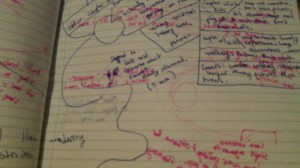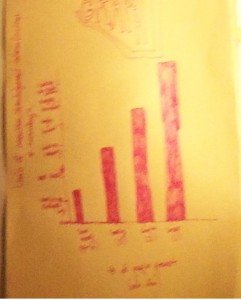Quantitave Contemplation
This week was one of many intricate patterns and insights.
Image of raw data in field journal:QUANTITATIVE CONTEMPLATION:
1) Methods
I began my quantitative research
with a method of following people around to observe the shapes of their
circulation as well as their overall engagement with the surroundings. When I
first arrived on a warm and sunny Monday in the early afternoon I immediately
spotted 3 separate groups of moms with strollers. I ended up following all 3
different groups of mothers that day, for around 30-40 minutes each. I drew an
impression of their path in my field journal, and also recorded when, for how
long and why they stopped.
My attention then bounced
over to families with a mother, father and child present. I took note of the
same things as the mom teams. Then I focused on people in groups of two whether
it was friends or couples, and finally I studied people who had come alone.
Things felt borderline creepy
after many hours of following behind people, and trying not to be noticed. I began
to feel a bit like a stalker, so I then took a stance of stillness in a few
selected areas and gathered information based on what people took note of, how
they seemed to move, if they took time to read the informative plaques, how
long they stayed in a general area, and their apparent gender and estimated
age.
The research continued on a
not so sunny Tuesday afternoon. I refrained from following people this time and
stuck to still observation. My subjects of study were the same with the
exception of the mom groups (they weren’t present, possibly due to the clouds and
the cool weather) and the particular things I looked for (movement patterns,
place of focus/interest, amount of time spent, etc.) remained the same as well.
2) Analysis
Many different patterns
emerged from my research. For each mom group the experience seemed to be fast
paced, and more of a time for socializing. They didn’t ever stop and really
look at anything. In fact, the only time any one of the groups did stop, take
their children out of the strollers, get off the main path, and participate in
something other than fast paced walking and talking was to take pictures of one
another posing with the kids. Even though they passed by all kinds of brightly
colored children’s attractions, that isn’t what they were there for.
This wasn’t the case for the
families with a mother, father, and child present. They seemed to have a much
more interactive experience. Stopping to appreciate natural attractions, and
walking at a slower pace, they possessed a whole different mindset and course
of action. Something I found particularly interesting: all of these families
pulled their children in wagons, giving them the option to stop and get out,
rather than the groups of mothers who ALL had strollers, strapping their
children in. It served as an illustration of the difference in levels of contact:
one group was buckled into a self-restricted experience, and the other
participated in both being inside and out of an involved undertaking.
The connections seemed to
grow stronger with groups of two people. These couples not only took time to
make observations of objects such as a particularly beautiful patch of flowers
or a designated waterfall, but actually went so far as to engage in
conversation about it, or even lean down to touch, or smell, or achieve a
closer look at a feature of their interest. The older these pairs were the more
immersed they remained in the journey, the more time they took with everything.
The people who traveled
alone seemed to expand their time to the fullest extent. They practiced the
power of silence and seemed to truly take in the beauty of the landscape. One
man stopped every 20 feet for ten minutes straight to capture photographs of
the nature, and then simply gaze out into the distance with eyes of wonder.
Another woman repeatedly suspended herself: she paused in time and became lost
in contemplation, her eyes soaked in the surrounding. To observe her was to
feel the presence of her calming thought.
Both the couples and the
loners seemed to wonder rather than walk. They had a mix of directions that
they chose to turn (where as the mom teams turned right EVERY time), and when
these wonderers were drawn to something enough to acquire a more complete
sensory experience, it was always something natural: ponds of colorful coy
fish, a radiant bunch of plants, the flowing of waterfalls or the undeniable
expressions that blossom from tree branches. Their experience seemed to reflect
the environment: it was natural.
3) Interpretation
These patterns are layers of connection with
nature, and they incorporate mirror neurons. The mother groups are the inner
layer (farthest away). They’re making an effort to submerse themselves in
nature by being present in the first place, but since they have set themselves
up in a social situation the true essence of what is around them isn’t fully
internalized.
The families of a mother,
child, and father have less of a social event dynamic going, so it is less
likely that they will feel the need to entertain one another, and more probable
that they will engage with the environment. The same goes for the groups of two
people. One on one interaction has a completely different feeling (that is why
they’re so essential for strong relationships). People are much more likely to notice
the surroundings, take it in together, and make it the mutual subject of
interest between them (or at least this was the impression I acquired from my
research).
Even if the groups of two
get closer to connecting, I believe that the people who are by themselves are
more likely to internalize the beauty surrounding them. This belief is partly
due to my knowledge of mirror neurons “…which become active both when an
individual executes an act and when he observes it being executed by others.”1
If a human is around another human it is likely that they will choose to
mirror the person around them; but if there is no one else with them, if they
are alone with nature, they may choose to internalize that instead, thus
obtaining a greater understanding of its life and inner workings. A deep internalization
of this could become very beneficial due to the connection to the outer world
that plants possess: “…plants are constantly observing and recording events and
phenomenon of which man- trapped in his anthropocentric view of the world,
subjectively revealed to him through his five senses- knows nothing.”2
Notes: 1 Rizzolatti, Giacomo, and Corrado Sinigaglia.
Preface. Mirrors in the Brain: How Our Minds Share Actions and Emotions.
Oxford: Oxford UP, 2008. Print.
2 Tompkins, Peter, and Christopher Bird. Introduction. The
Secret Life of Plants. New York: Harper & Row, 1973. Print.
Graphic Information Chart:
This
chart simply depicts the results acquired from my research: the fewer amounts
of people present, the more acknowledgement/engagement/mirroring of the environment.
The number of people and category of group (team moms, family, pair, and loner)
are at the bottom and decrease from the left to right. The levels of engagement
are depicted vertically, and increase with height.
ANNOTATED BIBLIOGRAPHY: annotate
Insightful Log:
(3.5)Saturday: Reading the quantitative essay, 12-2. Coloring in field journal: 1-2:30 (am) I had a
nice adventure in Dallas today, but it did underline the importance of The Arboretum.
You wouldn’t know what nature was if you grew up in this city without the
informative escape of the botanical garden. It is a sore thumb of green in a
land of concrete.
(4) Sunday: studying in library, 4:30-6, working on
annotated bib 6:20-7:50, attempting to meditate on quantitative 9-10. I had a
break down. I didn’t feel like there was going to be any room for me to be
creative in the assignments this week, and I was just feeling lost and discouraged
rolling around on my floor. My grandmother went to the hospital.
(6.25)Monday: collecting quantitative research 12:30-4:45, working
on bib and revising history 8:30-10:30. Today was a bit brighter. I enjoyed
collecting my research. Some interesting patterns emerged that I feel I can
work with, and expand on tomorrow. In order to be a healthy human, I think an
intimate, one on one connection with some aspect of nature is essential. I have decided not to let things stress me.
(4.5)Tuesday: Collecting research 1:30-5, beginning phase
one of post 9-10. I had a really nice conversation with Kelli. It really helped
to reconnect me with the community. I also got on a real pattern kick today. I
start to contemplate all of the reoccurring patterns that reflect each other
throughout this life: tree branches and plant roots mirroring our brain stems
as well as the branches of lightning. The translucent unfathomably complicated
patterns that emerge on the surface of water which are often times reflected by
cloud formations. It goes on and on. I feel like I understand life better
today. Someone asked me what I wanted to do with my life, and I responded
effortlessly. I want to combine art and music and nature in a form of consciousness
therapy. I don’t know how I will achieve this, but it is nice to know that I do
have a tangible goal of some sort.
(9)Wednesday: worked on quantitative: 12-5, 10-1. meditation 6-7. I had a
mirror neuron breakthrough in relation to my research, and I also discovered
that my new friend Julia is mentally insane. I take interest in her because
these are the types of people I would most likely be working with if I was some
sort of art/nature therapist as I was envisioning so clearly yesterday. We almost
got in a car accident and died. I am glad to be alive.
(8.5)Thursday: Annotated bib and blog post all throughout
all day and night. Today has been a
handful of forced focus. Tomorrow is my last Dallas day. I have gained some
insight and understanding that I’ve come to highly value. A sour week turned
sweet.
Total: 35.5 Looks like I’m a tad short this week, but I’m sure if you counted all the time I spent thinking or worrying about school related things, I’d be right at 40. Hopefully it will balance out due to my overtime in previous weeks.




